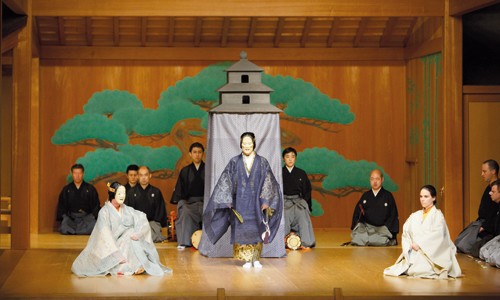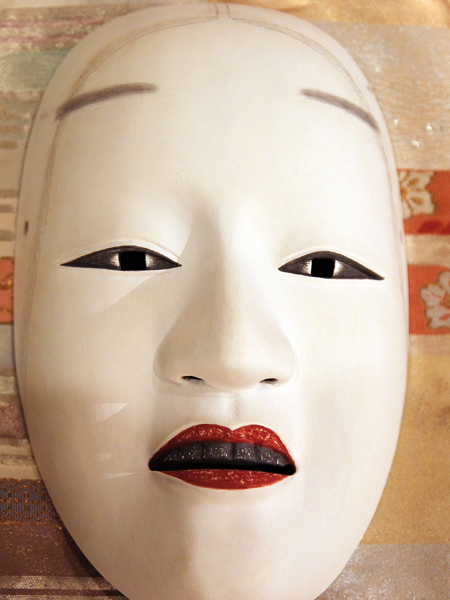Just say 'Noh'
 0 Comment(s)
0 Comment(s) Print
Print E-mail
Global Times, July 4, 2011
E-mail
Global Times, July 4, 2011
 |
|
Pagoda, Theatre Nohgaku’s contemporary English Noh play, investigates identity and migration. |
Although Noh, (Nogaku or, sometimes, “Japanese opera”) is the oldest musical drama in Japan, with 700 years’ history, only a limited number of foreign theaters actually appreciate Noh plays.
The National Centre for the Performing Arts is one, though. Two Noh plays, one in Japanese, the other in English, are being staged tonight in Beijing, by the Oshima Noh Theatre and the Tokyo and New York-based Theatre Nohgaku (TN).
The classic warrior play Kiyotsune will play alongside contemporary the Pagoda, which was written in 2009 by British playwright Jannette Cheong with music by Richard Emmert, and explores themes of identity and migration.
The troupes’ first Asian tour will also present a series of workshops on Noh mask-making and performance on Wednesday and Thursday in Hong Kong, following ones at Peking University and Beijing’s Penghao Theater over the weekend.
Stylistic power
A form of “mask drama” that reached its high point in the 1400s, Noh, which literally means “skill” or “talent,” is known for its chanting, dancing, captivating stories, poetic texts and diverse masks.
Noh’s formalized settings are often interwoven with Buddhist traditions and beliefs, and provide a deep insight into Japanese culture. The plots usually recreate famous scenes from well-known works of Japanese literature, such as The Tale of Genji or The Tale of the Heike and include imaginary conversations with ghosts to resolve current issues.
Accompanied by a chorus and a hayashi ensemble of three drummers and one flautist, the singing involves a limited tonal range, while the lengthy and repetitive passages are structured in a narrow dynamic range.
Although the plays are not that dramatic in Western terms, the emphasis on allusions, stylistic form and inner power make it popular among Noh audiences. Emmert, the artistic director and a founding member of TN, has devoted himself to the art for over 40 years.
“The movements are very economical, but very powerful,” he argued. Noh’s style can still be interesting to theatergoers, he added.
TN founder member Jubilith Moore has seen massive changes in her 18 years in the business, thanks to Noh’s stylized power, she said.
“As a performer, I like to be completely engaged and I found Noh does that,” said Moore, who plays three or four major Japanese and English Noh plays a year and hosts workshops across the US.
“If you continue working as a performer, you have to listen, you have to dance, you have to sing, you have to think about interpretations, you have to work in a mask,” she noted. “It changes pretty much everything: The way I view the world, the way I view my art and the way I view each day.”
English Noh tradition
Although traditionally, Noh plays are sung in native Japanese and the music is specially composed for Noh’s poetic form, artists from English-speaking countries have strived to introduce Noh since 1916, beginning with W. B. Yeats’ At the Hawk’s Well.
Following the success of Pagoda, Emmert is currently working on a more contemporary Elvis Presley play, called Blue Moon over Memphis.
“Noh is very cross-borders and it’s not particularly Japanese,” claimed Emmert. The tradition of communing with one’s ancestors is common in other culture and artistic forms as well (think Christian Slater’s chats with an imaginary Presley in the film True Romance) – anyone who is interested in getting some insight from the past will be intrigued, he added.
 |
|
The Noh mask is the spirit of Noh plays. Photo: CFP |
While a number of classical Western operas have been transferred to a modern setting and given new interpretations for a contemporary audience, Noh, with its focuses on tradition over innovation, generally tolerates little in the way of individual interpretations.
In fact, to make it more appealing, the key, suggested Emmert, is simply to keep the way it is. Although the audience of Noh is mainly limited to intellectuals in Japan and people interested in alternative theater, Emmert is quite optimistic about its future. Noh has never been a populist art, so why would people want to make it one, Emmert asked: “If you want to be entertained, you can go to a movie.”






Go to Forum >>0 Comment(s)